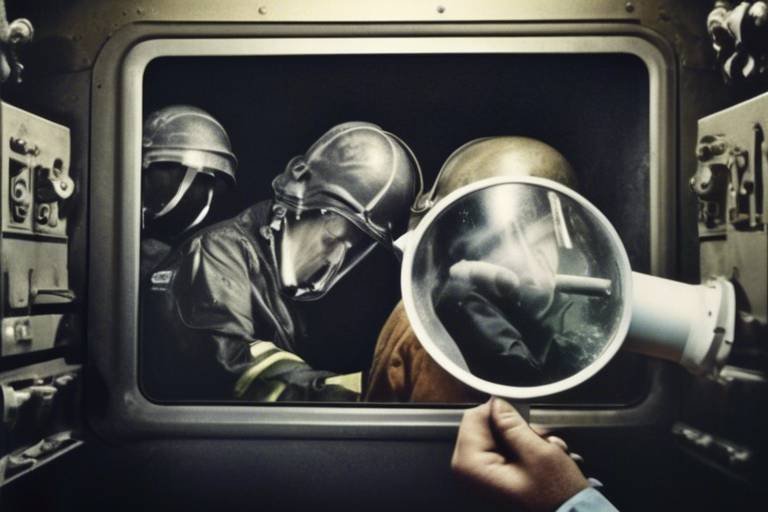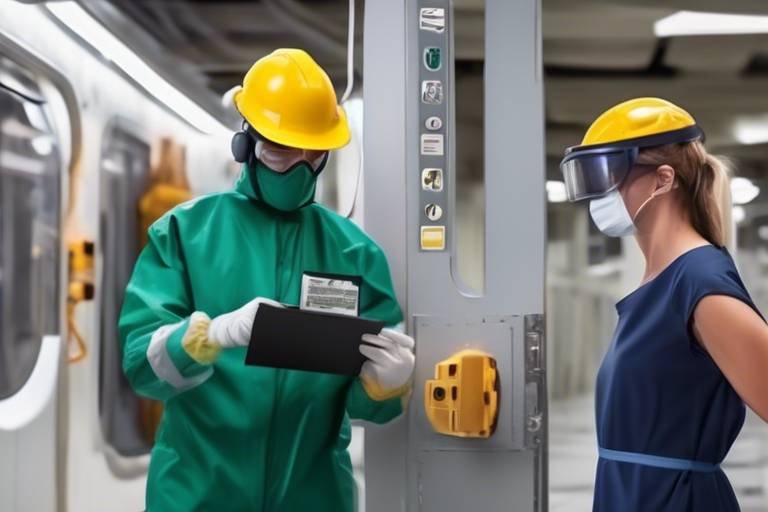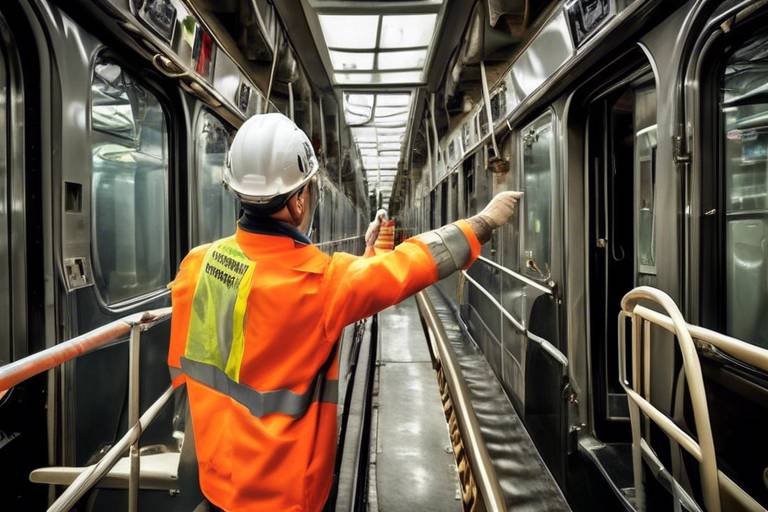Underrated Role of Human Behavior in Determining Safety Measures
When we think about safety measures, our minds often drift towards regulations, equipment, and protocols. However, the unsung hero in this narrative is human behavior. It's fascinating to consider how our actions, decisions, and perceptions play a pivotal role in the effectiveness of safety measures. Imagine a world where all the safety equipment is in place, yet accidents still happen. Why? Because the human element is often overlooked. This article will dive deep into the psychological and cultural factors that influence safety behaviors, ultimately revealing why understanding human behavior is crucial for promoting safety in various environments.
At its core, safety is not just about the rules we follow; it's about the people who follow them. Whether in a workplace, at home, or in public spaces, the way individuals perceive risk and respond to safety protocols can either enhance or undermine safety efforts. For instance, consider a construction site where workers are equipped with helmets and harnesses. If they're not motivated to wear them or underestimate the risks involved, the effectiveness of those safety measures diminishes significantly. This brings us to the heart of the matter: human behavior is both a determinant and a barrier to safety.
As we explore this topic, it’s essential to recognize that safety measures can be meticulously designed, but if the people who are supposed to implement them don’t buy into the process, the entire system falters. Thus, understanding the psychology behind risk perception and compliance becomes paramount. What drives individuals to adhere to safety protocols? What are the emotional and cognitive factors that influence their decisions? These questions will guide our exploration into the underrated role of human behavior in determining safety measures.
Understanding how individuals perceive risk is crucial for developing effective safety measures. Our brains are wired to assess danger, but this process is often influenced by cognitive biases and emotional responses. For example, people may underestimate risks associated with familiar activities, thinking, "It won't happen to me." This phenomenon, known as the optimism bias, can lead to dangerous complacency. On the other hand, fear can also skew our perception, causing individuals to overreact to certain risks while ignoring others. It's essential to address these biases in safety training and communication.
Culture plays a vital role in shaping safety behaviors. Different cultures have unique norms and values that impact how individuals perceive safety and adhere to protocols. In some cultures, there’s a strong emphasis on individual responsibility, while in others, collective responsibility prevails. This can significantly influence how safety measures are implemented and followed. For instance, in a culture where safety is viewed as a communal effort, individuals may feel more compelled to adhere to safety protocols, knowing that their actions affect the group.
Social norms can either encourage or discourage safe behavior. Peer influence and societal expectations drive compliance with safety measures in various contexts. For instance, if a group of employees regularly adheres to safety protocols, new members are likely to follow suit, creating a culture of safety. Conversely, if risky behaviors are normalized within a group, individuals may feel pressured to conform, undermining safety efforts. This highlights the importance of fostering positive social norms that prioritize safety.
Discussions on whether safety is an individual or collective responsibility reveal insights into human behavior. While individual accountability is crucial, collective responsibility can enhance safety outcomes. When individuals feel that their actions contribute to the well-being of others, they are more likely to comply with safety measures. This dual perspective emphasizes that safety is a shared commitment, requiring both personal accountability and collective action.
Understanding what motivates individuals to follow safety protocols is essential. There are two primary types of motivators: intrinsic and extrinsic. Intrinsic motivators stem from personal values and beliefs, such as a genuine concern for one’s safety or the safety of others. Extrinsic motivators, on the other hand, include rewards, recognition, or even penalties for non-compliance. Balancing these motivators can enhance compliance and promote a safety-first mindset across various environments.
Behavioral economics provides insights into how people make decisions regarding safety. Factors such as incentives, framing, and defaults can significantly impact safety-related choices. For example, presenting safety measures as the default option can lead to higher compliance rates. Understanding these behavioral nuances allows organizations to design safety protocols that align with human decision-making processes, ultimately enhancing safety outcomes.
Education and training are critical in shaping safe behaviors. Effective training programs not only impart knowledge but also foster a culture of safety. Engaging training sessions that incorporate real-life scenarios can help individuals understand the importance of safety measures and how their behavior impacts overall safety. Additionally, ongoing education ensures that individuals stay informed about the latest safety protocols and practices.
Clear communication is essential for conveying safety information. Utilizing various strategies, such as visual aids, interactive workshops, and regular updates, can enhance understanding and compliance among individuals regarding safety measures. It’s not just about telling people what to do; it’s about ensuring they understand why it matters. When individuals see the relevance of safety measures in their daily lives, they’re more likely to adopt them.
Feedback mechanisms are vital for improving safety practices. Gathering and analyzing feedback from individuals can lead to a better understanding of safety challenges and opportunities for improvement. This iterative process not only enhances safety protocols but also empowers individuals to take an active role in promoting safety within their environments.
- Why is human behavior important in safety measures?
Human behavior influences how safety protocols are perceived and followed, making it essential for effective safety measures. - How can culture affect safety behavior?
Cultural norms and values shape individuals' attitudes towards safety, impacting their adherence to safety protocols. - What motivates individuals to follow safety protocols?
Both intrinsic and extrinsic motivators play a role in encouraging compliance with safety measures. - How can effective communication improve safety compliance?
Clear and engaging communication helps individuals understand the importance of safety measures, leading to better adherence.

The Psychology of Risk Perception
Understanding how individuals perceive risk is crucial for developing effective safety measures. It's fascinating to realize that our brains are wired to interpret danger in various ways, often influenced by cognitive biases and emotional factors. For instance, have you ever noticed how some people seem to underestimate risks associated with certain activities, like driving without a seatbelt or ignoring safety signs? This isn't just recklessness; it's a result of how we process information about risk. Our perception can be skewed by personal experiences, societal influences, and even media portrayals of danger.
Cognitive biases play a significant role in shaping our understanding of risk. For example, the availability heuristic leads us to overestimate the likelihood of events that easily come to mind. If we hear about a plane crash on the news, we might think flying is more dangerous than it actually is, even though statistically, it's one of the safest modes of transportation. This bias can lead to fear and avoidance, ultimately affecting our behavior in ways that may not align with reality.
Moreover, emotional factors such as fear and anxiety can cloud our judgment. When faced with a potential threat, our instinct is often to react emotionally rather than rationally. This emotional response can lead to irrational decisions, such as taking unnecessary risks or failing to follow safety protocols. For instance, during a fire drill, individuals might panic and ignore the clearly marked exits, demonstrating how emotions can override learned safety behaviors.
To illustrate the complex interplay between perception and behavior, consider the following table that outlines different cognitive biases and their effects on risk perception:
| Cognitive Bias | Description | Effect on Risk Perception |
|---|---|---|
| Availability Heuristic | Overestimating the likelihood of events that are easily recalled | Leads to fear of flying after hearing about a crash |
| Optimism Bias | Believing that negative events are less likely to happen to oneself | Underestimating the need for safety measures |
| Confirmation Bias | Seeking out information that confirms existing beliefs | Ignoring safety protocols that contradict personal views |
In addition to cognitive biases, our social environment plays a pivotal role in shaping how we perceive risk. The opinions of friends, family, and even social media can influence our attitudes towards safety. For instance, if your friends frequently engage in risky behavior, you might feel pressured to conform, downplaying the associated risks. This phenomenon highlights the importance of understanding the social context when developing safety measures.
Ultimately, recognizing the psychological underpinnings of risk perception is essential for creating effective safety protocols. By addressing cognitive biases and emotional reactions, we can design interventions that not only inform but also resonate with individuals on a deeper level. After all, safety is not just about rules and regulations; it's about understanding the human mind and how it interacts with the world around us.

Culture is like the invisible thread that weaves through our lives, influencing our thoughts, actions, and even our safety behaviors. It's fascinating how the environment we grow up in shapes our perceptions of safety. For instance, in some cultures, taking risks is celebrated, while in others, caution is deeply ingrained. This cultural backdrop plays a pivotal role in determining how individuals respond to safety measures. Have you ever noticed how some people seem to disregard safety protocols, while others follow them religiously? This disparity often boils down to cultural influences.
One significant aspect of culture that impacts safety behavior is the value placed on individualism versus collectivism. In individualistic cultures, personal freedom and self-expression are often prioritized, which can lead to a more casual attitude towards safety measures. Conversely, collectivist cultures emphasize group harmony and shared responsibility, often resulting in stronger adherence to safety protocols. For example, in a workplace setting, an employee from a collectivist background may feel a greater obligation to comply with safety regulations to protect their colleagues, while someone from an individualistic culture might prioritize their own comfort over communal safety.
Moreover, cultural norms dictate how we perceive authority and compliance. In some societies, questioning authority is seen as a form of disrespect, which can lead to blind adherence to safety rules, even when they seem excessive. On the other hand, cultures that encourage critical thinking may foster an environment where individuals feel empowered to challenge safety protocols, potentially leading to improvements but also risks if not managed properly.
To illustrate this point, consider the following table that outlines how different cultural dimensions affect safety behavior:
| Cultural Dimension | Individualistic Cultures | Collectivist Cultures |
|---|---|---|
| Risk Tolerance | Higher risk-taking behavior | More cautious and risk-averse |
| Compliance with Authority | Questioning norms | Strict adherence to rules |
| Responsibility | Individual responsibility | Group responsibility |
| Communication Style | Direct and open | Indirect and context-sensitive |
Another crucial factor is the role of social norms within different cultures. Social norms can either encourage or discourage safe behavior, acting like a double-edged sword. In cultures where safety is a shared value, individuals are likely to feel a sense of duty to comply with safety measures. For instance, if a community collectively prioritizes road safety, individuals are more likely to wear seatbelts and follow traffic rules. However, in communities where such norms are weak or absent, individuals may feel less compelled to act safely.
Ultimately, understanding the cultural influences on safety behavior is essential for crafting effective safety measures. By recognizing these nuances, organizations can tailor their safety training and communication strategies to resonate better with their workforce. After all, a one-size-fits-all approach rarely works when it comes to human behavior. Instead, by embracing cultural differences, we can foster a more robust safety culture that encourages everyone to prioritize safety in their daily lives.
- How does culture affect safety behavior? Culture shapes our values, beliefs, and attitudes towards safety, influencing how we perceive risks and comply with safety measures.
- What role do social norms play in safety compliance? Social norms can either promote or deter safe behaviors, depending on the collective values of a community.
- Can safety measures be effectively implemented across different cultures? Yes, but it requires understanding and adapting to the cultural context to ensure that safety measures resonate with individuals.

When we think about safety, we often focus on rules, regulations, and the physical measures in place to protect us. However, what many people overlook is the profound impact of social norms—the unwritten rules that govern behavior within a group. Have you ever noticed how you might buckle your seatbelt just because everyone else in the car does? That’s social norms at work! These norms can either act as a powerful motivator for safe behavior or, conversely, as a significant barrier to compliance.
Social norms are shaped by the collective attitudes and behaviors of a community. They create a framework within which individuals operate, often influencing decisions more than formal rules. For example, in workplaces where safety is a priority, employees are more likely to adhere to safety protocols if they see their peers consistently following them. This phenomenon is known as peer influence, and it can be a double-edged sword. If the prevailing attitude is one of disregard for safety, individuals may feel pressured to conform to unsafe practices, which can lead to serious consequences.
Moreover, the power of social norms can be illustrated through the concept of social proof. When people observe others engaging in a particular behavior, they are more likely to adopt that behavior themselves. This is particularly relevant in safety contexts. For instance, if a group of friends regularly wears helmets while biking, newcomers to the group are likely to follow suit, not just because of the safety benefits, but because they want to fit in. This highlights the importance of fostering a culture where safe practices are the norm rather than the exception.
To illustrate the impact of social norms on safety, consider the following table, which summarizes different scenarios and their corresponding social influences:
| Scenario | Social Norm Influence |
|---|---|
| Workplace Safety Meetings | Encourages collective responsibility and adherence to safety protocols. |
| Group Outdoor Activities | Promotes safe behaviors like wearing life jackets or helmets. |
| Public Spaces (e.g., parks) | Can either discourage littering or promote safety depending on group behavior. |
It's also essential to recognize that social norms can vary significantly across different cultures and communities. What is considered acceptable behavior in one group may be frowned upon in another. This cultural lens shapes how individuals perceive safety and can either enhance or undermine compliance with safety measures. For instance, in cultures where hierarchy is emphasized, employees may feel less empowered to speak up about safety concerns, fearing repercussions from authority figures.
In summary, understanding the role of social norms in safety behavior is crucial for developing effective safety strategies. By fostering an environment where safe practices are not only encouraged but expected, organizations and communities can significantly enhance compliance. It’s about creating a culture where safety is a shared value, and everyone feels responsible for upholding it. So next time you buckle up or wear a helmet, remember: you’re not just following a rule; you’re part of a larger social fabric that values safety!
- What are social norms? Social norms are the unwritten rules that govern behavior within a group, influencing how individuals act in various situations.
- How do social norms affect safety behavior? They can either encourage safe practices or lead to unsafe behaviors, depending on the collective attitudes of the group.
- Can social norms change over time? Yes, social norms can evolve as attitudes shift within a community or organization, often influenced by education and awareness campaigns.

When it comes to safety, the debate between individual responsibility and collective responsibility is not just a theoretical exercise—it's a critical conversation that can shape the effectiveness of safety measures in any environment. Imagine you’re at a concert. The safety protocols are in place, but the real question is: who is responsible for ensuring that everyone adheres to them? Is it solely the individual's duty to follow the rules, or does the responsibility extend to the group as a whole?
On one hand, individual responsibility emphasizes personal accountability. Each person is expected to understand and comply with safety measures. This perspective promotes the idea that if everyone takes ownership of their actions, the overall safety of the environment improves. For instance, think about wearing a seatbelt. While it’s a personal choice, the collective impact of individuals making that choice leads to significantly lower accident fatalities. However, relying solely on individual actions can be problematic. What happens when someone chooses not to follow the rules? The safety of the entire group can be compromised.
Conversely, collective responsibility shifts the focus to the community or organization as a whole. This approach advocates for a system where everyone looks out for one another, creating an environment where safety is a shared goal. In workplaces, for example, fostering a culture of safety means that employees not only follow safety protocols but also encourage their colleagues to do the same. This could be likened to a team sport, where every player’s actions affect the team's overall performance. If one player disregards the game plan, the entire team suffers.
So, how do we reconcile these two perspectives? The truth is, they are not mutually exclusive. Both individual and collective responsibilities can coexist harmoniously to enhance safety outcomes. For instance, organizations can implement policies that encourage individual accountability while simultaneously fostering a culture of teamwork. This dual approach can be particularly effective in high-risk environments, such as construction sites or laboratories, where the consequences of negligence can be dire.
To illustrate this further, consider the following table that outlines the benefits of combining individual and collective responsibilities:
| Responsibility Type | Benefits |
|---|---|
| Individual Responsibility |
|
| Collective Responsibility |
|
In conclusion, the interplay between individual and collective responsibility is crucial in determining how safety measures are perceived and implemented. By fostering a culture that values both aspects, we can create safer environments that not only protect individuals but also promote a sense of community. After all, safety is not just about following rules; it’s about looking out for one another and recognizing that our actions can have a ripple effect on those around us.
- What is individual responsibility in safety? Individual responsibility in safety refers to the expectation that each person takes accountability for their own actions and follows safety protocols.
- How does collective responsibility enhance safety? Collective responsibility fosters a supportive environment where everyone looks out for one another, leading to improved adherence to safety measures.
- Can individual and collective responsibilities coexist? Yes, both can coexist and are essential for creating a comprehensive safety culture.
- What are some examples of collective responsibility in safety? Examples include team safety meetings, peer monitoring, and shared safety training programs.

When it comes to safety compliance, understanding what motivates individuals is paramount. Safety measures are only as effective as the willingness of people to adhere to them. This brings us to the core of the issue: the motivational factors that drive compliance. These factors can be broadly categorized into two types: intrinsic motivators and extrinsic motivators.
Intrinsic motivators are internal drives that compel individuals to act in a safe manner. For instance, a person may feel a strong sense of personal responsibility to keep themselves and others safe. This internal compass often stems from a deep-seated belief in the value of life and health. Think of it like a personal code of ethics; when someone genuinely cares about the well-being of others, they are more likely to follow safety protocols diligently. This sense of duty can be further enhanced through education and personal experiences, where past incidents create a lasting impact on behavior.
On the other hand, extrinsic motivators involve external factors that encourage compliance. These can include rewards, recognition, or even penalties for non-compliance. For example, many workplaces implement safety incentive programs that reward employees for adhering to safety guidelines. This creates a tangible reason for individuals to follow protocols, as the prospect of a reward can be a powerful motivator. Moreover, the presence of strict regulations and the threat of fines can also serve as a deterrent against unsafe practices.
Moreover, the effectiveness of these motivational factors can vary based on context. In a workplace setting, factors such as management support, peer pressure, and organizational culture play a crucial role in shaping safety behaviors. When employees see their colleagues actively participating in safety measures, they are more likely to follow suit due to social influence. This is where the power of social norms comes into play, reinforcing the idea that safety is a collective responsibility.
Ultimately, fostering a culture that prioritizes safety requires a blend of both intrinsic and extrinsic motivators. Organizations can enhance compliance by creating an environment where safety is valued and recognized. For instance, regular training sessions can not only educate employees about safety protocols but also serve as a platform for sharing success stories and recognizing those who exemplify safe behavior. This dual approach not only enhances compliance but also cultivates a sense of community and shared responsibility.
In conclusion, understanding the motivational factors behind safety compliance is crucial for developing effective safety measures. By addressing both intrinsic and extrinsic motivators, organizations can create a more robust safety culture that encourages individuals to prioritize safety in all aspects of their lives.
- What are intrinsic motivators for safety compliance? Intrinsic motivators are internal drives, such as personal responsibility and ethical beliefs, that compel individuals to prioritize safety.
- How can organizations enhance extrinsic motivators? Organizations can implement reward systems, recognition programs, and clear consequences for non-compliance to enhance extrinsic motivators.
- Why is social influence important in safety compliance? Social influence creates a sense of accountability among peers, encouraging individuals to adhere to safety protocols when they see others doing the same.
- Can education improve safety behaviors? Yes, effective education and training programs can significantly improve safety behaviors by informing individuals about risks and safe practices.

When we talk about safety, it’s easy to think of hard hats and safety nets. But what really shapes our decisions about safety? This is where behavioral economics comes into play. It’s a fascinating field that dives deep into the quirks of human decision-making, especially when it comes to safety. Imagine you’re at a construction site. You see a sign that says, “Hard hats required.” Now, why do some people comply while others don’t? The answer lies in the intricate dance of incentives, framing, and defaults.
One of the key concepts in behavioral economics is the idea of incentives. These are the carrots and sticks that motivate our actions. For instance, if workers are rewarded for following safety protocols—say, through bonuses or recognition—they’re more likely to comply. Conversely, if there are no clear incentives, compliance may drop. This is particularly important in environments where safety is paramount, like construction or manufacturing. In these settings, understanding what drives people can make all the difference.
Another critical factor is how information is presented, or framing. The way we perceive risks can change dramatically based on how they are communicated. For example, if a safety protocol is framed as a way to protect your loved ones, it might resonate more deeply than if it’s presented merely as a rule. This emotional connection can compel individuals to take safety measures seriously. Think about it: Would you follow a safety guideline more diligently if it meant ensuring your family’s well-being?
Defaults also play a significant role in shaping safety decisions. When given a choice, people often stick with the default option. For instance, if a safety training program automatically enrolls employees unless they opt out, compliance rates are likely to soar. This is because it’s easier to go with the flow than to make an active choice to opt out. By setting the right defaults, organizations can nudge individuals toward safer behaviors without requiring significant effort on their part.
In summary, behavioral economics offers invaluable insights into how we make safety-related decisions. By leveraging incentives, framing, and defaults, we can create environments that not only encourage but also enhance compliance with safety measures. It’s about understanding the psychology behind our choices and using that knowledge to foster a culture of safety. After all, when safety becomes second nature, everyone wins.
- What is behavioral economics?
Behavioral economics studies how psychological factors influence economic decision-making, particularly in contexts like safety. - How do incentives affect safety compliance?
Incentives can motivate individuals to follow safety protocols by providing rewards or recognition for safe behavior. - What role does framing play in safety decisions?
Framing refers to how information is presented; effective framing can enhance the perceived importance of safety measures. - Why are defaults important in safety practices?
Defaults influence decision-making; people are more likely to comply with safety measures when they are the default option.

When it comes to safety, education and training are not just important—they're absolutely essential. Think of it this way: if safety measures are the walls of a house, education and training are the foundation that keeps everything standing strong. Without a solid understanding of safety practices, even the best protocols can crumble under pressure. So, how do we ensure that individuals are equipped with the knowledge and skills necessary to maintain a safe environment? It all starts with effective training programs.
Effective training is like a well-tuned engine; it needs the right fuel to run smoothly. This fuel comes in the form of comprehensive education that addresses the specific safety needs of different environments. Whether it's in a corporate office, a construction site, or a healthcare facility, tailored training can make a world of difference. For instance, a construction worker needs to know about fall protection and equipment handling, while an office employee should focus on ergonomics and emergency evacuation procedures.
Moreover, the way information is delivered plays a critical role in how well it is received. Engaging training sessions that incorporate interactive elements—like simulations, role-playing, and hands-on practice—can significantly enhance retention and understanding. Imagine trying to learn how to ride a bike just by reading a manual; it simply doesn't work! In the same vein, safety training must be experiential, allowing individuals to practice what they learn in a controlled environment.
Another key aspect of education in safety practices is the use of real-life scenarios. By presenting participants with case studies or past incidents, trainers can help them understand the consequences of neglecting safety measures. This not only emphasizes the importance of compliance but also fosters a culture of safety where individuals feel responsible for their own well-being and that of their colleagues.
To further enhance the effectiveness of safety training, organizations should implement a system of continuous improvement. This involves regularly updating training materials to reflect new regulations, technologies, and best practices. Gathering feedback from participants is crucial; it allows trainers to identify areas for improvement and tailor future sessions to better meet the needs of the workforce. A feedback loop can look like this:
| Feedback Method | Purpose | Frequency |
|---|---|---|
| Surveys | Gauge understanding and satisfaction | Post-training |
| Focus Groups | Deep dive into specific issues | Quarterly |
| One-on-One Interviews | Personal insights and suggestions | Bi-annually |
In summary, education and training in safety practices form the backbone of any successful safety initiative. By investing in comprehensive, engaging, and continually evolving training programs, organizations can cultivate a workforce that not only understands safety protocols but actively promotes a culture of safety. After all, when it comes to safety, a well-informed individual is the best line of defense.
- Why is safety training important? Safety training is crucial as it equips individuals with the necessary skills and knowledge to prevent accidents and respond effectively in emergencies.
- How often should safety training be conducted? Safety training should be conducted regularly, with updates whenever there are changes in regulations or workplace environments.
- What types of training are most effective? Interactive and hands-on training methods tend to be the most effective, as they engage participants and enhance retention of information.
- How can feedback improve safety training? Feedback helps identify gaps in training and allows for continuous improvement, ensuring that the training remains relevant and effective.

When it comes to safety, effective communication is the backbone that holds everything together. Imagine trying to build a house without a solid foundation; that’s what poor communication does to safety protocols. Clear, concise, and engaging communication can mean the difference between life and death in critical situations. But what does effective communication look like in the context of safety? It’s not just about relaying information; it’s about ensuring that the message resonates with the audience. This involves understanding your audience's needs, preferences, and even their emotional states.
One of the key strategies for effective communication in safety practices is to use simple language. Safety jargon might sound impressive, but it can alienate or confuse people. Instead, using straightforward terms makes the information accessible to everyone, regardless of their background. For instance, instead of saying “personal protective equipment,” you might say “safety gear.” This small change can significantly impact how well the message is received.
Visual aids also play a crucial role in enhancing understanding. Think about how much easier it is to grasp a concept when you can see it. Infographics, charts, and diagrams can simplify complex safety procedures and make them more relatable. For example, a flowchart illustrating the steps to take in case of a fire can be far more effective than a lengthy written procedure. When people can visualize the steps, they are more likely to remember and follow them.
Additionally, engaging your audience through interactive methods can boost retention and compliance. Workshops, role-playing scenarios, and hands-on training sessions encourage active participation, which can lead to better understanding and commitment to safety practices. When people actively participate, they’re not just passive recipients of information; they become part of the safety culture.
Furthermore, feedback is essential in refining communication strategies. After conducting safety training or meetings, soliciting feedback can provide insights into what worked and what didn’t. This two-way communication fosters an environment where individuals feel valued and heard, which can enhance their willingness to comply with safety measures. It’s like tuning an instrument; continuous feedback helps ensure that everyone is playing in harmony.
Lastly, utilizing technology can elevate your communication strategies. In today’s digital age, leveraging tools like mobile apps, SMS alerts, and online platforms can facilitate timely and effective communication. For example, sending out push notifications about safety drills or updates can keep everyone informed and prepared. It’s about meeting people where they are and using the tools they’re familiar with to ensure the safety message is not just heard but acted upon.
In summary, effective communication strategies in safety practices involve a blend of simplicity, visual aids, engagement, feedback, and technology. By prioritizing these elements, organizations can foster a culture of safety that resonates with everyone involved. After all, when communication flows smoothly, safety becomes a shared responsibility, and that’s when real change happens.
- What are the key elements of effective communication in safety?
The key elements include clarity, engagement, visual aids, feedback, and the use of technology.
- How can visual aids improve safety communication?
Visual aids simplify complex information, making it easier for individuals to understand and remember safety procedures.
- Why is feedback important in safety communication?
Feedback allows organizations to refine their communication strategies, ensuring that messages are effective and resonate with the audience.
- How can technology enhance safety communication?
Technology can facilitate timely communication through apps, SMS alerts, and online platforms, keeping everyone informed and prepared.

When it comes to safety practices, the journey is never truly complete. Just like a well-oiled machine, continuous improvement is essential to ensure that safety measures evolve and adapt to new challenges. Feedback plays a pivotal role in this process, acting as the oil that keeps the gears turning smoothly. By actively seeking feedback from individuals who engage with safety protocols, organizations can identify gaps, misunderstandings, and areas for enhancement.
Imagine a workplace where employees feel empowered to voice their concerns and suggestions about safety practices. This open dialogue not only fosters a culture of trust but also leads to practical solutions that might have otherwise gone unnoticed. For instance, if workers consistently report that a particular safety procedure is cumbersome or unclear, management can revise it to be more user-friendly. This iterative process benefits everyone, as it aligns safety measures with the real-world experiences of those who are on the front lines.
Moreover, feedback mechanisms can take various forms, from anonymous surveys to regular safety meetings. Each method has its benefits and can be tailored to fit the unique culture of an organization. Here’s a simple table illustrating different feedback methods and their potential advantages:
| Feedback Method | Advantages |
|---|---|
| Anonymous Surveys | Encourages honest feedback without fear of repercussions. |
| Regular Safety Meetings | Facilitates open discussion and team collaboration. |
| Suggestion Boxes | Provides a straightforward way for employees to share ideas. |
| Observation and Reporting | Allows for real-time feedback on safety practices. |
Implementing a robust feedback system is not just about collecting data; it’s about acting on it. Organizations must ensure that feedback is not only acknowledged but also analyzed and integrated into safety protocols. This proactive approach can lead to significant enhancements in safety compliance and overall workplace morale. When employees see that their input leads to tangible changes, they are more likely to engage with safety measures actively.
Furthermore, creating a feedback loop allows organizations to assess the effectiveness of the changes made. For instance, after implementing a new safety protocol based on employee feedback, it’s crucial to monitor its impact. Are incidents decreasing? Are employees more satisfied with the safety measures? Continuous assessment ensures that the safety practices remain relevant and effective, ultimately leading to a safer environment for everyone.
In conclusion, the role of feedback in safety practices cannot be overstated. It’s the cornerstone of continuous improvement, ensuring that safety measures are not static but dynamic, evolving with the needs of the organization and its employees. By fostering a culture of open communication and responsiveness, organizations can create a safer, more compliant, and more engaged workforce.
Q: Why is feedback important in safety practices?
A: Feedback is crucial because it helps identify gaps in safety measures, encourages employee engagement, and fosters a culture of continuous improvement.
Q: What are some effective methods for gathering feedback?
A: Effective methods include anonymous surveys, regular safety meetings, suggestion boxes, and real-time observation and reporting.
Q: How can organizations ensure that feedback leads to action?
A: Organizations should analyze feedback, communicate changes made in response to it, and continuously assess the effectiveness of those changes.
Frequently Asked Questions
- What is the role of human behavior in safety measures?
Human behavior plays a crucial role in determining how effective safety measures are. Understanding psychological factors, such as risk perception and motivation, can help improve compliance with safety protocols.
- How does risk perception influence safety practices?
Risk perception is shaped by cognitive biases and emotional responses. When individuals misjudge the level of danger, they may either take unnecessary risks or become overly cautious, impacting their adherence to safety measures.
- What cultural factors affect safety behavior?
Cultural norms and values significantly influence how people behave regarding safety. In some cultures, safety regulations may be strictly followed, while in others, they might be seen as optional, affecting overall compliance.
- How do social norms impact safety compliance?
Social norms can either promote or hinder safe behavior. When safety is valued and practiced within a community, individuals are more likely to comply with safety measures due to peer influence and societal expectations.
- Is safety an individual or collective responsibility?
Safety can be viewed from both individual and collective perspectives. While individuals must take personal responsibility for their actions, a culture of safety within a group enhances overall compliance and effectiveness of safety measures.
- What motivates people to follow safety protocols?
Motivational factors can be intrinsic, like personal values, or extrinsic, such as rewards or penalties. Understanding these motivators is essential for cultivating a safety-first mindset among individuals.
- How does behavioral economics relate to safety decisions?
Behavioral economics examines how people make safety-related decisions. Factors like incentives, the way information is presented (framing), and default options can heavily influence individuals' choices regarding safety.
- Why is education important in safety practices?
Education and training are vital in shaping safe behaviors. Effective training programs help individuals understand safety protocols better, fostering a culture where safety is prioritized and practiced consistently.
- What are effective communication strategies for safety?
Clear and concise communication is key to conveying safety information. Utilizing various strategies, such as visual aids and straightforward language, can enhance understanding and compliance with safety measures.
- How can feedback improve safety practices?
Feedback mechanisms allow organizations to gather insights on safety practices. Analyzing this feedback can lead to continuous improvement, ensuring that safety measures are effective and relevant to the current environment.



















